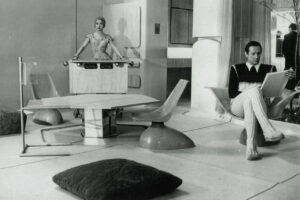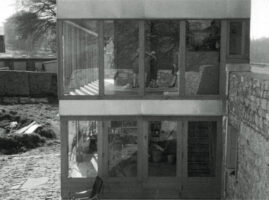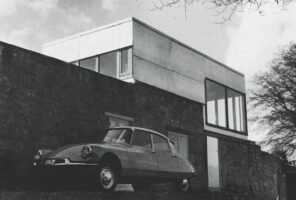Smithsons ‘As Found’
Review exhibition From the House of the Future to a house of today, Witte de With, Rotterdam, published in: De Architect, 2004
 The famous architects couple Alison and Peter Smithson have produced a multifaceted oeuvre over half a century. An exhibition created by Max Risselada and Dirk van den Heuvel on their residential projects is on display at the Witte de With contemporary art centre (now: Kunstcentrum Melly)in Rotterdam until 13 June.
The famous architects couple Alison and Peter Smithson have produced a multifaceted oeuvre over half a century. An exhibition created by Max Risselada and Dirk van den Heuvel on their residential projects is on display at the Witte de With contemporary art centre (now: Kunstcentrum Melly)in Rotterdam until 13 June.
Some of these occupy an important place in the Smithsons’ oeuvre. The duo built little, but designed many speculative projects and also wrote a lot. They represent a post-war modernism, in which new themes such as consumer society, the value of the existing city and the human appropriation of buildings replaced production-oriented functionalism. The Smithsons developed an ‘As Found’ approach in the Independence group that provides an important background to the heterogeneity of their designs. The House of the Future reflects a science fiction-like glamour, while the terrestrial Sugden House represents the conventions of the living hall, and their own country house at Upper Lawn incorporates the remains of an old mansion and a garden wall.
A difficulty in the interpretation of this work is that the Smithsons’ texts are not infrequently evangelical and offer summary explanations of concrete design choices. As Found represents a free handling of what has been found and a tendency to move towards the periphery of architecture. The Upper Lawn house, for example, is almost the same size as the former manor house, but shifted and rebuilt half a length. As a result, a former window emerges to the exterior space of the house. As a visual relic, the old house is contrasted with the perfection of the new mansion, but is not integrated typologically or constructively. It ultimately reflects a classical modernist attitude towards the history of the site. In the case of the lesser-known Cliff House, the captions note that the house was denied planning permission because the proposal would ignore an existing building. There is something to be said for this, but the curators follow the architects’ annoyance at this rejection.

This lack of distance is reflected in the construction of the exhibition using themes named and described by the architects themselves. As a result, the exhibition is arranged more or less chronologically. The suggestion arises that the design themes were developed one after the other and, moreover, are of similar weight. But the question is whether it is expedient, in the case of the Smithsons who boasted a well-run PR machine, to look behind the success presented and look for other angles. For instance, the section of the exhibition titled ‘At home with the Smithsons’ (in which the couple’s liberated living style is paradoxically depicted with meticulously staged domestic still lifes) is evidently trivial compared to the sections on mass housing and building on the periphery. The exhibition is most interesting when new material is shown, such as unknown designs, models of unrealised houses and the cleverly edited computer film about the House of the Future. The Smithsons’ work As Found is at last hesitantly interpreted here.

